Anti-tank SAU of Germany during the war (part 3) - StuG III
The first 5 experimental machines from the zero series left the factory floor a year later. As a base for their creation, a slightly modified middle base was used. tank PzKpfw III Ausf B. In the stationary, completely closed conning tower, the StuK 37 L / 24 short-barreled gun was mounted. The cannon was slightly shifted to the right relative to the longitudinal axis of the machine, so the driver’s position did not change, with the only difference being that he was now sitting in front of a fairly spacious fighting compartment, along the walls of which there was an ammunition of the gun, consisting of 44 shells. Initially, a machine gun for fighting the enemy infantry was not provided. For its time, the car was notable for good armor and low silhouette. Engine Maybach HL 108TR with a capacity of 250 hp allowed self-propelled guns to reach speeds of 20-25 km / h. For the combat vehicle, which was planned to be used as a means of supporting infantry, this speed was enough.
After making a number of changes to the design, in February 1940, the Daimler-Benz plant produced the first batch of assault guns, consisting of 30 combat vehicles, which differed from prototypes mainly by engine and chassis. The ACSs were manufactured on the basis of the PzKpfw III Ausf E / F tank and were equipped with the new Maybach HL 120TR engine, which has the 300 HP power. Frontal assault gun armor reached 50 mm. 28 March 1940, these assault guns were adopted by the Wehrmacht under the designation "7.5 cm Strumgeschutz III Ausf A (abbreviated - StuG III)". A little more than a month later 4 battery data SAU took part in the French campaign, the results of which earned the highest accolades from both the command and the crews of cars.
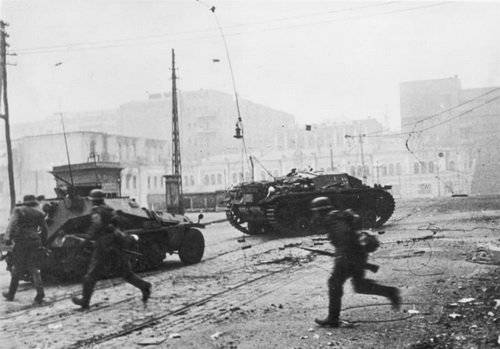
Soon, the production of self-propelled guns StuG III was transferred from the Daimler-Benz facilities overloaded with military orders to the Alkett enterprise, where the production of assault guns reached the level of 30 machines per month. Such production rates made it possible to commission the 1940 ACS StuG III in 184, and by the end of 1941, the number of these very necessary machines at the front reached 548.
As a result, the StuG III assault guns became the most massive tracked vehicle of the Wehrmacht during the Second World War. After in the 1942, the ACS received a new long-barreled 75-gun with good armor-piercing characteristics, this self-propelled gun became, in fact, the main anti-tank weapon of the Wehrmacht. At the same time, the function of the assault gun was transferred to the model StuH 42, armed with a short-barreled 105-mm howitzer, which has a much higher power high-explosive fragmentation shot. In total, from February 1940 to April 1945, German plants produced approximately 10 500 assault guns StuG III and assault howitzers StuH 42.
History modernization
Like all German armored vehicles, which were produced over a sufficiently long period of time, the StuG III was modernized several times during the production process. This was done both with the aim of improving the combat qualities of the self-propelled guns, and to reduce the cost and simplify the design. As a result of making most of the minor changes, 8 machine modifications (A, B, C, D, E, F, F / 8, and G) saw the light.
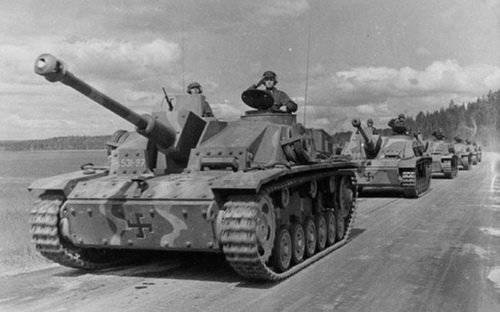
The main thing to pay attention to is the issue of the evolution of weapons. The first assault guns received short-barreled guns with a barrel length in 24 caliber. This weapon was the main for models A, B, C, D and E. The task of providing fire support for infantry on the battlefield, this tool coped well, but to fight with tanks with his help was very problematic, they could only be hit with very short distances. It is also worth noting that defensive armament in the form of a machine gun appeared on the ACS only from model C.
The very first battles against the USSR showed that the effectiveness of the StuG III in the fight against enemy tanks was very low. Namely, in this role well armored self-propelled guns often had to appear. In fairness it should be noted that in the same position when meeting with the new Soviet medium and heavy tanks were all tanks and self-propelled guns of the Wehrmacht.
That is why already September 28 1941, Hitler signs a special order, which calls for an increase in the power of the guns with which tanks and assault guns are armed. According to this order, all tanks and self-propelled guns should be armed only with long-barreled guns. For weapons StuG III preference was given to the gun StuK 40 L / 43 company Rheinmetall-Borsig, which fits perfectly into his cabin. The length of the gun barrel was equal to 43 caliber (3473 mm), the weight of the gun was 670 kg.
Production of assault guns with a new gun was launched in March 1942. The car received the designation Sturmgeschutz 40 Ausf.F The main difference between the model was a new gun, which was equipped with an Sfl ZF 1 sight, the head of which was brought out through a special hole located in the wheelhouse roof. Also, the machine received a new welded gun mask, and an electric fan was placed on the roof of the wheelhouse.
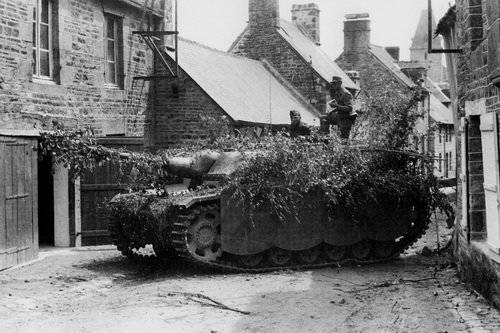
From June 1942, the body armor was reinforced with special 30-mm armor plates, which were attached to the main armor with bolts. The mass of the car increased by 450 kg, the maximum speed was reduced to 38 km / h. From August 1942, changes began to be made to the design of the frontal part of the ACS felling, in particular, the angle of inclination of the upper front sheets was reduced. Due to this, it was possible to remove the ledge, which is disadvantageous in terms of projectile resistance, located at the junction of the inclined and vertical frontal sheets of the hull. The assault gun in this version was produced from March to September 1942 of the year, in total 364 combat vehicles were produced.
In September of the same year, the workshops of the Alkett plant left the new version of Ausf.F / 8. Its main difference was in more manufacturable case. The thickness of the armor of the aft hull sheet was increased to 50 mm. All machines of this series were equipped with additional hinged armor in 30 mm in the frontal part of the cabin and the hull. From the beginning of 1943, they began to install a shield for the MG 34 machine gun on the roof of the conning tower, and since May 1943, the machines have received anti-cumulative screens. But the main feature was the new gun StuK 40 with a barrel length 48 caliber (3855 mm). The gun was equipped with a two-chamber muzzle brake and semi-automatic wedge gate, its weight was 750 kg. The direct shot range was equal to 800-1200 meters, the maximum firing range was 7 700 meters. The rate of fire was at the level of 10-15 rounds per minute, the gun ammunition consisted of 54 shells.
StuG III Ausf.G - the most popular PT-ACS of the Wehrmacht
At the very end of 1942, the latest and most massive modification, the StuG III Ausf.G, entered into service with the Wehrmacht. In this version, all the accumulated experience of combat use of self-propelled guns was embodied, and the latest design ideas were implemented. Until April, the 1945 of the Alkett plants produced the 5191 self-propelled gun in the Ausf.G version; in 1943, the company MIAG in Braunschweig also joined in their production. Here until March 1945, another 2643 of such machines was assembled. The total release of ACS StuG III Ausf.G amounted to 7834 units.
The main improvements touched the hull of the car, the armor for radio equipment on the sides of the hull were dismantled, due to which it was possible to expand the wheelhouse on the sides so that it began to act over the tracks. The rear part of the wheelhouse was slightly raised, an electric fan was installed in it, located above the gun gate. Later, the fan was moved to the rear vertical wall of the cabin. The car received a new commander's turret, including 8 viewing periscopes, which significantly improved the view from the car. In addition to this, the commander's hatch, which now consisted of 2 parts, underwent a change: the main one, which was attached to the rear part of the commander's turret, and the front part, which could be opened separately, in order to bring out the binocular surveillance device SF.14Z.
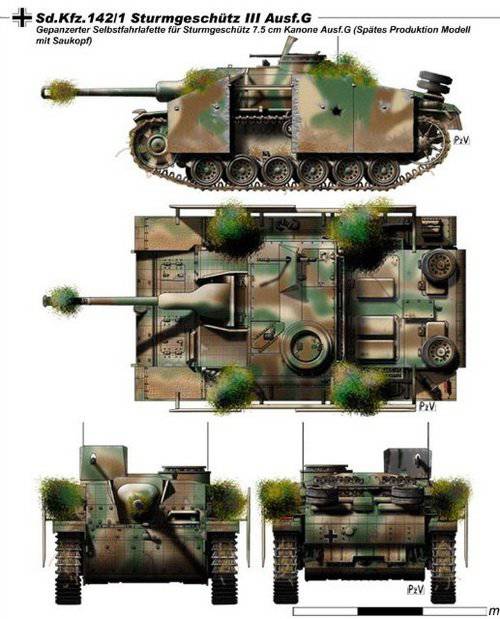
The commander's turret stood out noticeably above the cabin, while the thickness of its reservation was only 30 mm, which made it a rather vulnerable place. Since October, the 1943 of the year began to weld a special molded shield to the front of the turret and the roof of the wheelhouse, which contributed to the reflection of shrapnel and bullets.
The loader hatch was also bicuspid and consisted of the back and front flaps. In the open position, the front flap-shield was fixed with a special latch and used as a support for the machine gun. On later versions of the PT-ACS, the doors were rotated 90 degrees, so that they opened to the left and right of the gunner. Also on the roof in front of the gunner appeared a significant innovation - the MG 42 machine gun, controlled remotely. When the machine gun required reloading, the gunner protruded from his hatch. During this operation, he received relative protection, as the left and right doors were closed with an open hatch, and a small shield on the machine gun covered him from the front.
In May 1944 of the year to protect against the close-fitting enemy infantry StuG III Ausf.G began to arm a small mortar, which through a hole in the front of the roof could fire at 360 degrees with smoke or fragmentation grenades. A similar device was used on the German tanks Tiger and Panther. It is worth noting that most of the early versions of the StuG III Ausf.G were equipped with 90-mm NbK 39 grenade launchers, which were mounted to the left and right of the gun (total 6 pieces).
In November, the 1943 of the year or the beginning of the 1944 of the year, all self-propelled guns, instead of the old welded mask, began to be equipped with a new molded rounded mask, which was called the “pig nose” (German Saukopfblende). At the same time, models with an old mask were mass-produced. Over time, models with a welded mask even got an additional machine gun paired with a gun.
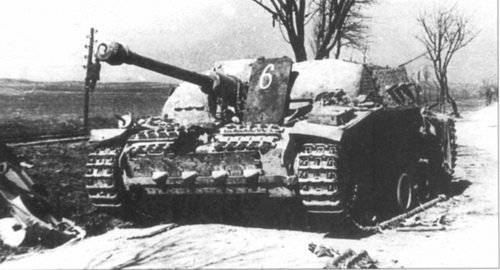
StuG III Ausf.G, destroyed near Lake Balaton. It is remarkable that the crew on the frontal cutting armor strengthened the concrete cushions, and also additionally booked all vertical surfaces with tracks from the T-34 tank.
During the production and operation of the StuG III Ausf.G, the developers decided to equip the self-propelled gun with onboard anti-cumulative screens. They were steel sheets 5 mm thick. At the same time, the shielded self-propelled guns became wider and could not be placed on the railway platform, therefore, during transportation, the mounted screens were removed from them. In addition, the screening brought another inconvenience. While driving, especially over rough terrain, screens clung to various obstacles and the ground. In order to get rid of this effect, already in the process of mass production, the lower corners of the front screens were simply cut off.
On the whole, the StuG III family should be recognized as a very successful self-propelled gun, which was used on all fronts of the Second World War and as a tank destroyer, both as an assault weapon, and as a defensive, and as an offensive weapon. All versions of the assault gun had a low silhouette, which made them a difficult target and a dangerous enemy for the enemy. The crews of the “things” were considered the elite of the armored forces of Germany and wore their own tank uniform of a gray-protective color. These self-propelled guns had a high rate of destroyed enemy tanks, by the spring of 1944, their number exceeded 20 000.
Specifications:
Performance characteristics of the StuG III Ausf G:
Mass: 23,4 t.
Dimensions:
Length 6,77 m., Width 2,88 m., Height 2,16 m.
Crew: 4 people.
Reservations: from 19 to 80 mm.
Armament: 75-mm gun StuK 40 L / 48, 7,92-mm MG-34 machine gun
Ammunition: 54 projectile, 900 ammo.
Engine: 12-cylinder gasoline liquid-cooled engine "Maybach" HL 120TRM power 300 hp
Maximum speed: on the highway - 38 km / h
Power reserve: on the highway - 155 km, over rough terrain - 95 km.
Information